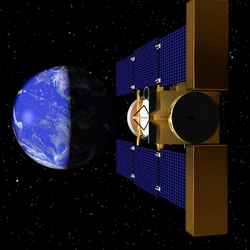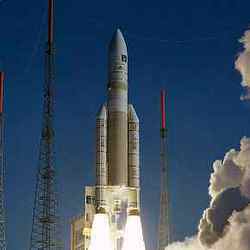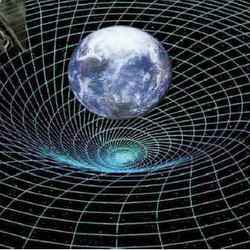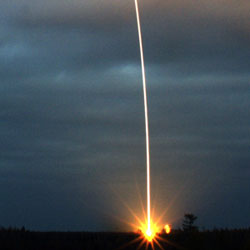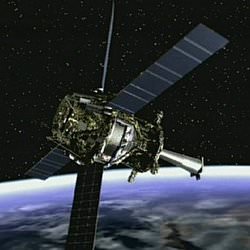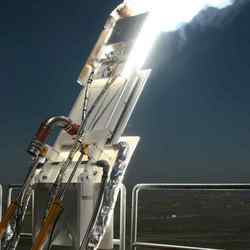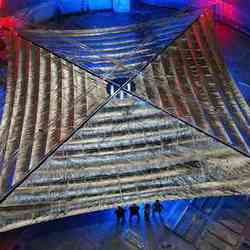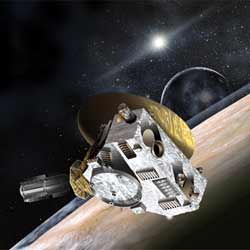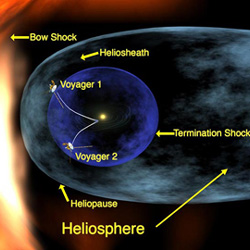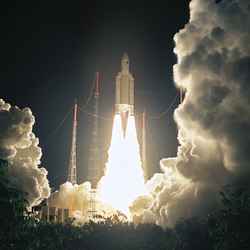
Ariane 5 lift off from the Guiana Space Centre. Image credit: ESA Click to enlarge
The second member of Europe’s new generation of weather satellites has successfully been lifted onto orbit, continuing an uninterrupted series of launch successes since 1977.
This ninth Meteosat satellite, developed on behalf of EUMETSAT under the aegis of the European Space Agency, will reinforce EUMETSAT’s capacity to monitor the Earth atmosphere above Europe, Africa, the Middle-East and the Atlantic Ocean.
MSG-2 (2nd flight model of Meteosat Second Generation) was one of the two payloads of Ariane 5’s latest launch. The European launch vehicle lifted off from the Guiana Space Centre, Europe’s spaceport, in Kourou, French Guiana, at 19:33 local time on 21 December (23:33 CET).
The Ariane 5GS vehicle successfully delivered its two passenger payloads onto a near perfect geostationary transfer orbit. The MSG-2 satellite is now under control of ESA’s European Space Operations Centre (ESOC) in Darmstadt, Germany, under a contract with EUMETSAT. In the coming days, it will perform a series of orbital manoeuvres using its onboard propulsion system in order to circularize its orbit at geostationary altitude.
“The successful launch of the second Meteosat satellite today reinforces the cooperation between the European Space Agency (ESA) and EUMETSAT in the designing and development of a series of missions devoted to meteorology” said Volker Liebig, ESA’s Director of Earth Observation programmes.
“Two further MSG satellites, planned to be launched, will guarantee continuity of services until around 2018. MSG- 2 improves today the provision of essential data and information for operational weather forecast and sustainable development” he continued.
MSG-2 is the first of three satellites based on the same design and procured by ESA on behalf of EUMETSAT, the European weather satellite organization, founded in 1986 and now encompassing all 17 ESA member states plus Turkey. Bulgaria, Croatia, the Czech Republic, Estonia, Hungary, Iceland, Latvia, Romania, Serbia-Montenegro, Slovakia and Slovenia are also contributing states to the organisation.
A new eye to watch our weather
The MSG satellites are designed to observe the Earth in twelve spectral bands and to deliver pictures every 15 minutes in visible light, infrared and at water vapour wavelength, with a ground resolution of 1 km. In all, they are able to return 10 times more data than the satellites of the original series.
Weighing about 2 metric tons at launch, the MSGs are twice and half heavier than their predecessors, but about half of this mass is propellant for reaching the operational orbit and station-keeping for about 7 years. They keep the same drum-shaped design but at a larger scale, with a 3.22-m diameter and a height of 3.74 m.
The payload is composed of two radiometers, SEVIRI and GERB. The Spinning Enhanced Visible & Infrared Imager (SEVIRI) observes the Earth in 12 spectral bands in visible light and infrared and delivers a picture of the hemisphere every 15 minutes. This allows to follow closely the development of rapidly evolving weather phenomena like storms, blizzards and fog. Its ground resolution in visible parts of the spectrum is 1 km, in order to monitor highly localized events.
The Global Earth Radiation Budget (GERB) experiment measures the amount of solar radiation reflected into space by the Earth and atmosphere, providing vital information about global climate change.
Besides these two instruments, MSG satellites carry a comprehensive communications payload for satellite operation, data communication and user data dissemination. It also includes a Search and Rescue transponder to relay distress signals from ships, aircraft and others in peril to the emergency services.
Witnessing global climate change
Once in geostationary orbit, MSG-2 will undergo several months of in-orbit commissioning before being operational. A first picture of the Earth captured by the SEVIRI instrument should be released by late January. In summer 2006 , MSG-2 is expected to enter operational service above the Gulf of Guinea, at 0 degree of longitude.
Renamed Meteosat 9, it will replace Meteosat 8 as the primary satellite to monitor the atmosphere and the climate. Meteosat 8 will be moved to 3.4 degrees West as a back-up satellite in order to ensure continuity of service in any circumstance. In addition EUMETSAT still operates the first-generation Meteosat 5, 6 and 7 satellites with an extended coverage over the Indian Ocean.
The MSG programme was decided in 1990 as follow-on to the highly successful original Meteosat series, with the introduction of new, more powerful and more accurate sensors, for a continuous observation of Earth’s atmosphere. With two more satellites currently ordered, the MSG series should provide coverage at least through 2018. This uninterrupted monitoring lasts since the very first Meteosat satellite, which was developed and launched by ESA in 1977. The Meteosat data are a unique testimony on the evolution of the planet’s climate over nearly three decades and its consequences on our weather.
Original Source: ESA Portal

